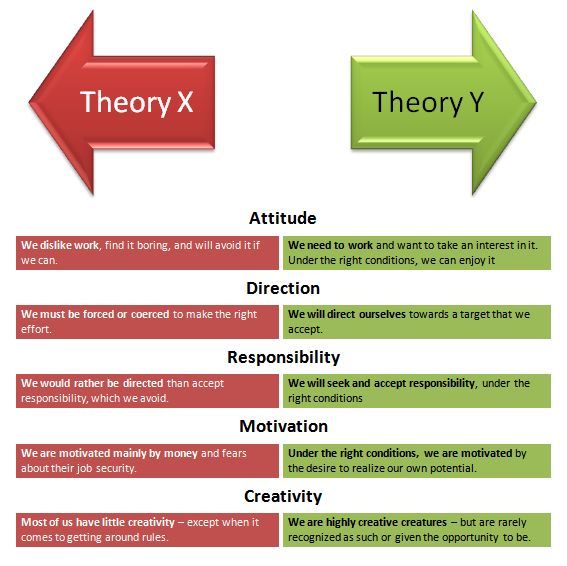Douglas Mcgregor Theory X Theory Y Pdf Reader
During the past 30 years, managers have been bombarded with two competing approaches to the problems of human administration and organization. The first, usually called the classical school of organization, emphasizes the need for well-established lines of authority, clearly defined jobs, and authority equal to responsibility. The second, often called the participative approach, focuses on the desirability of involving organization members in decision making so that they will be more highly motivated. Douglas McGregor, through his well-known “Theory X and Theory Y,” drew a distinction between the assumptions about human motivation which underlie these two approaches, to this effect: • Theory X assumes that people dislike work and must be coerced, controlled, and directed toward organizational goals. Furthermore, most people prefer to be treated this way, so they can avoid responsibility.
• Theory Y—the integration of goals—emphasizes the average person’s intrinsic interest in his work, his desire to be self-directing and to seek responsibility, and his capacity to be creative in solving business problems. It is McGregor’s conclusion, of course, that the latter approach to organization is the more desirable one for managers to follow. 1 McGregor’s position causes confusion for the managers who try to choose between these two conflicting approaches. The classical organizational approach that McGregor associated with Theory X does work well in some situations, although, as McGregor himself pointed out, there are also some situations where it does not work effectively.
Aug 11, 2014 - 5 min - Uploaded by Jessica BlaisdellUnit 5 video on McGregor's Theory X & Y, managers perceptions of employee motivations. Motivation is the reason for people's actions, desires, and needs. Motivation is also one's direction to behavior, or what causes a person to want to repeat a.

At the same time, the approach based on Theory Y, while it has produced good results in some situations, does not always do so. That is, each approach is effective in some cases but not in others. How can managers resolve the confusion? A New Approach Recent work by a number of students of management and organization may help to answer such questions. 2 These studies indicate that there is not one best organizational approach; rather, the best approach depends on the nature of the work to be done.
Enterprises with highly predictable tasks perform better with organizations characterized by the highly formalized procedures and management hierarchies of the classical approach. With highly uncertain tasks that require more extensive problem solving, on the other hand, organizations that are less formalized and emphasize self-control and member participation in decision making are more effective. In essence, according to these newer studies, managers must design and develop organizations so that the organizational characteristics fit the nature of the task to be done.
While the conclusions of this newer approach will make sense to most experienced managers and can alleviate much of the confusion about which approach to choose, there are still two important questions unanswered: 1. How does the more formalized and controlling organization affect the motivation of organization members? (McGregor’s most telling criticism of the classical approach was that it did not unleash the potential in an enterprise’s human resources.) 2. Equally important, does a less formalized organization always provide a high level of motivation for its members? (This is the implication many managers have drawn from McGregor’s work.) We have recently been involved in a study that provides surprising answers to these questions and, when taken together with other recent work, suggests a new set of basic assumptions which move beyond Theory Y into what we call “Contingency Theory: the fit between task, organization, and people.” These theoretical assumptions emphasize that the appropriate pattern of organization is contingent on the nature of the work to be done and on the particular needs of the people involved. We should emphasize that we have labeled these assumptions as a step beyond Theory Y because of McGregor’s own recognition that the Theory Y assumptions would probably be supplanted by new knowledge within a short time. Nuova Elettronica Handbook To Higher on this page. 3 The Study Design Our study was conducted in four organizational units.